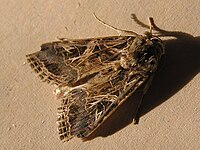
Photo from wikipedia
Background The Egyptian cotton leafworm, Spodoptera littoralis (Boisd.) (Lepidoptera: Noctuidae) is one of the major insect pests, causing a significant damage on different cultivated agricultural crops. Developing an alternative non-chemical… Click to show full abstract
Background The Egyptian cotton leafworm, Spodoptera littoralis (Boisd.) (Lepidoptera: Noctuidae) is one of the major insect pests, causing a significant damage on different cultivated agricultural crops. Developing an alternative non-chemical tool, an effective and environmentally friendly method to suppress pest's infestation is essentially needed. Therefore, biological control by releasing the egg parasitoids could be the most promising tool for integrated pest management. Results This study was designed to evaluate the efficacy of the egg parasitoid, Trichogrammatoidea bactrae Nagaraja (Hymenoptera: Trichogrammatidae) as a bio-control agent against S. littoralis egg masses with different physical characteristics (number of egg layer and degree of scale density) in a no-choice and choice tests, under laboratory conditions. Also, the parasitoids’ fitness in terms of parasitism percentage, developmental period, adults’ emergence percentage, female offspring percentage, and longevity were investigated. The results revealed that T. bactrae wasps had a great ability to parasitize S. littoralis egg masses, but with different rates, related to their layers and scales’ thickness in both tests. The highest parasitism percentage was observed on one-layer eggs, followed by two layers. However, 3-layer eggs were the least preferable one. High numbers of adult emergencies (> 80%) were observed in all tested egg masses, except in the case of 3 layers with high scales. Furthermore, female-biased sex ratios were noticed at all examined eggs, with only the exception of high-scaly eggs with a single layer that recorded the lowest rate (≤ 45%). Besides, the survival of adult female parasitoids was not significantly affected in both tests. Conclusions T. bactrae could be used as a bio-control agent against S. littoralis egg masses with different physical characteristics based on the achieved results.
Journal Title: Egyptian Journal of Biological Pest Control
Year Published: 2021
Link to full text (if available)
Share on Social Media: Sign Up to like & get
recommendations!